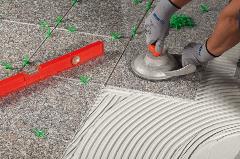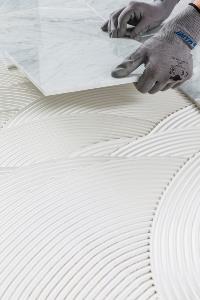Tiga permasalahan umum: penyerapan air, stabilitas dimensi dan pemilihan sistem pemasangan
Sebagai contoh, mari kita pilih tiga bahan yang berkualitas baik: Marmer Carrara, Marmer Verona Merah dan Batu Luserna. Tapi apakah mereka semua benar-benar jenis marmer? Bisakah saya menggunakan metode aplikasi yang sama untuk ketiganya? Bagaimana mereka menghadapi kondisi lembab? Ini semua adalah pertanyaan yang cukup mendasar tetapi, seperti yang diketahui oleh para installer, terlepas dari nama komersialnya, mereka tidak sama sama sekali. Performa mereka dalam hal kekuatan tekan, ketahanan abrasi, penyerapan air dan kemudahan dalam pekerjaan, misalnya, dapat sangat bervariasi. Dan bukan sebuah kebetulan membagi bahan batuan ke dalam keluarga yang berbeda: marmer, granit, travertine dan batu alam (yang mencakup segala sesuatu yang tidak tercakup dalam definisi lain). Mari kita lihat masing-masing dari tiga aspek berikut secara terpisah: penyerapan air, stabilitas dimensi dan memilih sistem pemasangan yang tepat.

1. Apakah material batuan yang digunakan untuk lantai dan dinding pada bangunan tempat tinggal sensitif terhadap air?
Beberapa dari mereka, ya. Adanya kelembapan di bawah lantai marmer, misalnya, dapat menyebabkan munculnya noda yang tidak sedap dipandang dalam berbagai warna di permukaan, seperti kuning atau merah (yang seringkali tidak dapat diubah). Dalam kasus tertentu, bagian belakang batuan menyerap begitu banyak air sehingga elemen batuan dapat berubah bentuk secara permanen. Dari mana datangnya air di bawah lantai? Dari substrat yang belum dikeringkan dengan benar, misalnya, atau jika tidak ada material penghambat uap air yang memadai untuk melawan naiknya kelembapan. Dalam kasus tertentu, bahan batuan juga dapat menyerap air yang terkandung dalam perekat itu sendiri.

2. Uji stabilitas dimensi
Tujuan dari pengujian ini adalah untuk mengetahui performa material batuan yang akan dipasang ketika bersentuhan dengan air yang terkandung dalam perekat yang digunakan untuk pemasangan. Metode pengujian khusus ini terdapat dalam lampiran standar Italia UNI 11714,1 mengenai pemasangan lantai dan dinding batuan. Bagaimana tes ini dilakukan? Secara sederhana, dengan memposisikan material yang dipilih pada penyangga yang terhubung ke serangkaian sensor yang presisi. Jumlah air dalam sistem pemasangan disimulasikan di bagian belakang pelat dan, secara berkala beberapa jam, jumlah pergerakan dalam material yang diuji dicatat. Beberapa bahan tidak mengalami deformasi sama sekali, sementara yang lain memiliki tingkat deformasi yang cukup besar. Jadi apa yang harus kita lakukan?
3. Sistem pemasangan mana yang harus dipilih?
Jika material batuan memiliki dimensi yang stabil, sistem pemasangan normal dapat digunakan. Dalam hal ini, sistem mana yang akan digunakan bergantung pada faktor lain, seperti ukuran, luasan, serta persyaratan dan kondisi lokasi tertentu. Jika bahan tidak stabil saat bersentuhan dengan air, di sisi lain, perlu untuk memilih sistem pemasangan yang cepat. Dengan demikian, air yang terkandung dalam perekat akan cepat habis oleh semen dan tidak akan bisa diserap oleh batuan alam. Perekat dengan kemampuan setting yang cepat diklasifikasikan dengan huruf F (cepat), sesuai dengan standar Eropa EN 12004. Di antara sistem pemasangan Mapei, contoh jenis ini adalah Elastorapid (C2FET S2) dan Granirapid (C2F S1). Dalam kondisi tertentu, ketika bahan batuan yang akan direkatkan memiliki pergerakan yang signifikan (≥ 6 mm), perekat tanpa campuran air harus digunakan. Mapei memproduksi dan mendistribusikan perekat berbahan epoxy-polyurethane Keralastic yang tidak mengandung air (R2). Dengan mempertimbangkan hal di atas, beberapa pertanyaan sederhana dapat mencegah masalah yang dihadapi di lokasi: apakah bahan yang akan saya gunakan sensitif terhadap kelembapan? Haruskah saya menggunakan sistem pemasangan dengan kemampuan setting yang cepat? Apakah substrat tempat material yang akan dipasang cocok untuk jenis batuan yang saya pilih?

Installation of stone materials
Three common problems: water absorption, dimensional stability and the choice of the installation system
For example purposes, let’s choose three (excellent) materials: Carrara Marble, Red Verona Marble and Luserna Stone. But are they all really types of marble? Can I use the same bonding method for all three of them? How do they behave in damp conditions? These are all pretty basic questions but, as any stone installer knows only too well, apart from their commercial names, they are not the same at all. Their behaviour in terms of compressive strength, abrasion resistance, water absorption and workability, for example, can vary quite considerably. And it is no mere coincidence that the reference norms divide stone materials into different families: marble, granite, travertine and natural stone (which includes everything not covered by the other definitions). Let’s look at each of the following three aspects separately: water absorption, dimensional stability and choosing the right installation system.

1. Are stone materials used for floor and wall coverings in the residential building sector sensitive to contact with water?
Some of them, yes. The presence of moisture underneath a marble floor, for example, can cause unsightly marks or stains in various colours to appear on the surface, such as yellow or red (which are often irreversible). In certain cases, the backs of slabs absorb so much water that a stone element can become permanently deformed. Where does the water underneath a floor covering come from? From a substrate that has not been dried correctly, for example, or if there is not an adequate vapour barrier to counteract rising damp. In certain particular cases, stone material may also absorb water contained in the adhesive itself.

2. Dimensional stability test
The aim of this test is to understand the behaviour of the stone material to be installed when it comes into contact with water contained in the adhesive used for installation. This particular test method is contained in an annex to the relative Italian standard UNI 11714.1 regarding the installation of stone floor and wall coverings. How is the test performed? In simple terms, by positioning a slab of the selected material on a support connected to a series of high-precision sensors. The amount of water in the installation system is simulated on the back of the slab and, at regular intervals of several hours, the amount of movement in the material being tested is recorded. Some materials do not deform at all, while others have quite large levels of deformation. So what should we do?
3. Which installation system should be chosen?
If the stone material is dimensionally stable, a normal-setting installation system may be used. In this case, which system to use depends on other factors, such as the size of the slabs, the final area of use and particular site requirements and conditions. If the material is unstable when it comes into contact with water, on the other hand, it is necessary to opt for a rapid installation system. In so doing, the water contained in the adhesive will be quickly consumed by the cement and won’t be able to be absorbed by the natural stone. Rapid adhesives are classified by the letter F (fast), in compliance with European standard EN 12004. Amongst the Mapei installation systems, examples of these types are Elastorapid (C2FET S2) and Granirapid (C2F S1). In certain particular conditions, such as when the stone material to be bonded has significant amounts of movement (≥ 6 mm), adhesive without water must be used. Mapei manufactures and distributes Keralastic epoxy-polyurethane adhesive containing no water (R2). In consideration of the above, a few simple questions can prevent problems being encountered on site: is the material I am about to bond sensitive to moisture? Should I use a rapid-setting installation system? Is the substrate on which the material is to be installed suitable for the type of stone I have chosen?

Comments
Load more comments